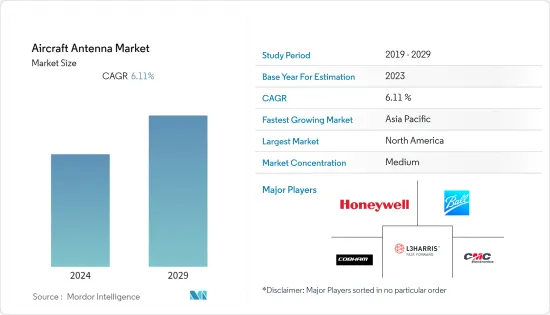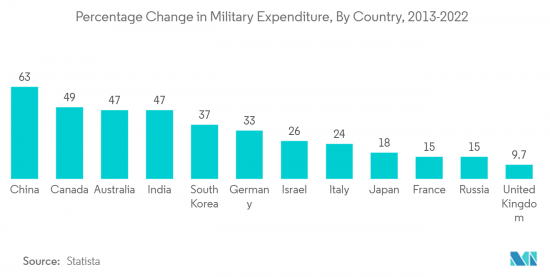
|
시장보고서
상품코드
1405346
항공기용 안테나 : 시장 점유율 분석, 산업 동향과 통계, 성장 예측(2024-2029년)Aircraft Antenna - Market Share Analysis, Industry Trends & Statistics, Growth Forecasts 2024 - 2029 |
||||||
항공기용 안테나 시장은 2024년에 5,446억 8,000만 달러로 평가되며, 2029년에는 7,326억 8,000만 달러에 달할 것으로 예측되며, 예측 기간 중 CAGR은 6.11%를 기록할 것으로 예상됩니다.

상용, 군용 및 일반 항공기의 차세대 항공기 개발은 소형, 고이득, 고 대역폭 안테나 수요를 촉진하고 있습니다. 예를 들어 민간 항공기내 연결성 향상에 대한 수요 증가로 인해 SATCOM 솔루션을 지원하는 Ku/Ka 대역 안테나가 설치되고 있습니다. 민간 항공업계의 여객 운송량 증가와 군 분야(유인 및 무인 플랫폼 모두)의 통신을 위한 독립적인 암호화 채널의 필요성이 광대역의 안전한 통신을 제공하는 첨단 안테나 개발에 대한 투자를 촉진하고 있습니다.
세계 시장을 촉진하는 다른 요인으로는 무인 항공기를 이용한 군 훈련에 대한 수요 증가와 첨단 통신 및 항법 시스템의 수용이 증가하고 있다는 점을 들 수 있습니다. 군 기관은 전장에서 사용되는 군용 무인 항공기 개발에 투자하고 있습니다. 이러한 UAV의 군용 용도에서 신뢰할 수 있는 통신은 매우 중요한 요소입니다. 그 결과, 주요 기업은 생산성 인증을 획득하여 기술 혁신과 운영 유사성의 성장으로 이어집니다.
항공기용 안테나 시장 동향
예측 기간 중 가장 높은 성장률을 보일 군 부문
세계 각국의 군비 증가는 차세대 항공기 조달과 첨단 기술을 통한 기존 항공기의 현대화 계획에 불을 지폈다.2022년 미국 국방부(DoD)는 군를 보다 강력하고 민첩하며 혁신적인 통합군으로 만들기 위해 7,530억 달러의 국방 예산을 요청했습니다. 이 예산에 따라 국방부는 차세대 항공 지배 프로그램 중 미래형 공격 정찰기, 미래형 장거리 강습기, 6세대 전투기 개발에 투자할 계획입니다. 이러한 프로그램은 초기 단계에 있으므로 항공기 안테나 제조업체는 이러한 프로그램의 신규 계약을 수주하고 시장에서의 입지를 강화할 수 있습니다.

예측 기간 중 아시아태평양이 가장 높은 수요를 창출할 것으로 예상
아시아태평양은 민간 항공 산업에서 전례 없는 장기적인 성장세를 보이고 있으며, 그 배경에는 이 지역 항공사에 인도될 예정인 수많은 항공기가 있습니다. 이러한 항공기 증가는 항공사가 관광, 무역 등 다양한 산업을 지원하기 위해 이 지역을 오가는 연결성을 향상시키는 데 도움이 되고 있습니다. 새로운 항공기에는 첨단 안테나 시스템이 장착되어 있으며, 여행자들은 점점 더 나은 기내 연결 서비스를 선택하고 있습니다. 각 항공사는 승객의 편의성을 높이기 위해 새로운 IFC 서비스를 제공합니다.
또한 이 지역 국가들의 군비 증가는 차세대 고성능 군용기 개발 및 조달을 지원하고 있습니다. 예를 들어 중국의 2023년 국방비 예산안은 2,250억 달러로 2022년 예산보다 7.2% 증가하여 8년 연속 군비 지출이 증가했습니다. 마찬가지로 인도의 2023년 국방비 예산안은 726억 달러로 지난 회계연도 당초 예상보다 13% 증가했으며, 전투기 구입을 목표로 하고 있습니다. 이 항공기에는 위성기, 항공기 및 항공기-지상국 간의 데이터 링크를 개선하기 위해 고급 안테나가 장착되어 있습니다. 위와 같은 이유로 아시아태평양의 항공기 안테나 수요는 예측 기간 중 가장 높은 CAGR을 기록할 것으로 예상됩니다.
항공기용 안테나 산업 개요
항공기용 안테나 시장은 다양한 주파수 대역(VHF &UHF Band, Ka/Ku/K Band, X Band, 기타), 다양한 모양과 크기의 안테나를 제공하는 여러 기업에 의해 적당히 통합되어 있습니다. 항공기 안테나 시장의 주요 업체로는 Cobham Limited, CMC Electronics Inc, L3Harris Technologies Inc, Honeywell International Inc, HR Smith Group of Companies 등이 있습니다.
기타 특전
- 엑셀 형식의 시장 예측(ME) 시트
- 3개월간의 애널리스트 지원
목차
제1장 서론
- 조사의 전제조건
- 조사 범위
제2장 조사 방법
제3장 주요 요약
제4장 시장 역학
- 시장 개요
- 시장 촉진요인
- 시장 억제요인
- Porter's Five Forces 분석
- 공급 기업의 교섭력
- 구매자·소비자의 교섭력
- 신규 진출업체의 위협
- 대체품의 위협
- 경쟁 기업간 경쟁 강도
제5장 시장 세분화
- 최종사용자
- 상업
- 군
- 일반 항공
- 애플리케이션
- 통신
- 내비게이션·감시
- 지역
- 북미
- 미국
- 캐나다
- 유럽
- 영국
- 프랑스
- 독일
- 이탈리아
- 러시아
- 기타 유럽
- 아시아태평양
- 중국
- 인도
- 일본
- 한국
- 호주
- 기타 아시아태평양
- 라틴아메리카
- 브라질
- 멕시코
- 기타 라틴아메리카
- 중동 및 아프리카
- 사우디아라비아
- 아랍에미리트
- 카타르
- 남아프리카공화국
- 기타 중동 및 아프리카
- 북미
제6장 경쟁 구도
- 벤더 시장 점유율
- 기업 개요
- CMC Electronics Inc.
- Cobham Limited
- L3Harris Technologies, Inc.
- Honeywell International Inc.
- Ball Corporation
- Hexagon AB
- RAMI
- HR Smith Group of Companies
- RTX Corporation
- PIDSO-Propagation Ideas & Solutions GmbH
- AeroVironment, Inc.
제7장 시장 기회 및 향후 전망
KSA 24.01.19
The Aircraft Antenna Market is valued at USD 544.68 billion in 2024 and is expected to reach USD 732.68 billion by 2029, registering a CAGR of 6.11% during the forecast period.
The development of next-generation aircraft for commercial, military, and general aviation is fuelling the demand for antennas with a smaller size, high gain, and bandwidth. For instance, the increasing demand for better connectivity onboard commercial aircraft led to the installation of Ku-/Ka-band antennas to support SATCOM solutions. Increasing passenger traffic in the commercial aviation industry and the need for a separate and encrypted channel for communication in the military sector (for both manned and unmanned platforms) are fuelling investments in the development of advanced antennas that provide large and secure bandwidth.
Other factors driving the global market are the increasing demand for military exercises by unmanned aerial vehicles and the growing acceptance of advanced communication and navigation systems. Military agencies are investing in developing military-grade drones that will be used on the battlefield. Reliable communication becomes a key aspect in such military applications of UAVs. In turn, the key players gain productive accreditations, leading to growth in innovation and operational similarity.
Aircraft Antenna Market Trends
The Military Segment to Experience the Highest Growth During the Forecast Period
The increasing military spending of countries around the world fueled the plans for procurements of new generation aircraft and modernization of existing aircraft with advanced technology. For FY 2022, the US Department of Defense (DoD) requested a defense budget of USD 753 billion to make its military force a more lethal, agile, and innovative joint force. Under this budget, the DoD planned to invest in the development of future attack reconnaissance aircraft, future long-range assault aircraft, and sixth-generation combat aircraft within the Next Generation Air Dominance program. These programs are in their initial stages, due to which the aircraft antenna manufacturers can capture new contracts for such programs to increase their presence in the market.
For instance, in March 2023, the United States Air Force Research Laboratory (AFRL) contracted with ThinKom Solutions, Inc. to deliver a modular and scalable phased-array antenna solution (ThinKom gateway array). Initially funded as a development contract, the offering takes advantage of ThinKom's patented Variable Inclination Continuous Transverse Stub (VICTS) architecture. Similarly, in June 2023, CesiumAstro won a US Air Force USD 3.6 million contract to develop a phased array antenna for remotely piloted drones. CesiumAstro will scale its SATCOM terminal to fit the size, weight, and power (SWaP) requirements of a Group 5 unmanned aerial system (UAS). The terminal will be integrated on a General Atomics MQ-9A capital asset to demo connectivity benefits with a commercial satellite network.

The Asia-Pacific Region is Expected to Generate the Highest Demand During the Forecast Period
The Asia-Pacific region is achieving unprecedented long-term growth in commercial aviation, backed up by a large number of aircraft scheduled for future delivery to carriers in the region. This increasing air fleet is helping the airlines to increase the connectivity to/from/within the region to support a wide spectrum of industries, like tourism and trade. The new aircraft are fitted with advanced antenna systems as travelers are increasingly opting for better onboard connectivity services. Companies are bringing new IFC services to passengers to enhance their experience.
Moreover, the growth of military spending of countries in the region is supporting the development and procurement of new-generation advanced military aircraft. For instance, China's proposed FY2023 defense spending 2023 rose to USD 225 billion, which is 7.2% higher than the budget allocated for FY2022 and is the eighth consecutive year of increase in its military spending. Similarly, India's proposed defense expenditure for FY 2023 is USD 72.6 billion, which is 13% up from the previous period's initial estimates and is aimed towards the acquisition of combat aircraft. These aircraft are fitted with advanced antennas to provide better data links between satellite aircraft, aircraft, and aircraft-ground stations. Due to the reasons above, the demand for aircraft antennas in the Asia-Pacific region is expected to register the highest CAGR during the forecast period.
Aircraft Antenna Industry Overview
The aircraft antenna market is moderately consolidated with several players that provide various antennas of various frequency ranges (VHF & UHF Band, Ka/Ku/K Band, X Band, and others) and different shapes and sizes. The prominent players in the aircraft antenna market are Cobham Limited, CMC Electronics Inc., L3Harris Technologies Inc., Honeywell International Inc., and HR Smith Group of Companies. Cobham Limited currently holds the highest market share in the commercial segment, as it provides communication and navigation antennas to the majority of Airbus and Boeing aircraft. Various players are investing in technological innovations in the design of advanced antenna systems for better and uninterrupted services. Such efforts are envisaged to enhance the business prospects of antenna manufacturers.
For instance, in February 2021, Satcom Direct released its first two Plane Simple satellite communication antennas, bringing lower-cost high-speed connectivity options to a wider array of airframes. While the SD Plane Simple Ku antenna will provide connectivity via Intelsat's broadband Ku-band satellite service, the SD Plane Simple Certus LEO antenna will access Iridium's new Next Low Earth orbit (LEO) L-band constellation and its high-speed Certus service. Similarly, in March 2021, Thinkom Solutions Inc. developed a new product variant of its VICTS aero satellite communication antennas. It enabled more flexible installation choices and allowed for smaller distributed and embedded phased-array applications.
Additional Benefits:
- The market estimate (ME) sheet in Excel format
- 3 months of analyst support
TABLE OF CONTENTS
1 INTRODUCTION
- 1.1 Study Assumptions
- 1.2 Scope of the Study
2 RESEARCH METHODOLOGY
3 EXECUTIVE SUMMARY
4 MARKET DYNAMICS
- 4.1 Market Overview
- 4.2 Market Drivers
- 4.3 Market Restraints
- 4.4 Porter's Five Forces Analysis
- 4.4.1 Bargaining Power of Suppliers
- 4.4.2 Bargaining Power of Buyers/Consumers
- 4.4.3 Threat of New Entrants
- 4.4.4 Threat of Substitute Products
- 4.4.5 Intensity of Competitive Rivalry
5 MARKET SEGMENTATION
- 5.1 End User
- 5.1.1 Commercial
- 5.1.2 Military
- 5.1.3 General Aviation
- 5.2 Application
- 5.2.1 Communication
- 5.2.2 Navigation and Surveillance
- 5.3 Geography
- 5.3.1 North America
- 5.3.1.1 United States
- 5.3.1.2 Canada
- 5.3.2 Europe
- 5.3.2.1 United Kingdom
- 5.3.2.2 France
- 5.3.2.3 Germany
- 5.3.2.4 Italy
- 5.3.2.5 Russia
- 5.3.2.6 Rest of Europe
- 5.3.3 Asia-Pacific
- 5.3.3.1 China
- 5.3.3.2 India
- 5.3.3.3 Japan
- 5.3.3.4 South Korea
- 5.3.3.5 Australia
- 5.3.3.6 Rest of Asia-Pacific
- 5.3.4 Latin America
- 5.3.4.1 Brazil
- 5.3.4.2 Mexico
- 5.3.4.3 Rest of Latin America
- 5.3.5 Middle East and Africa
- 5.3.5.1 Saudi Arabia
- 5.3.5.2 United Arab Emirates
- 5.3.5.3 Qatar
- 5.3.5.4 South Africa
- 5.3.5.5 Rest of Middle East and Africa
- 5.3.1 North America
6 COMPETITIVE LANDSCAPE
- 6.1 Vendor Market Share
- 6.2 Company Profiles*
- 6.2.1 CMC Electronics Inc.
- 6.2.2 Cobham Limited
- 6.2.3 L3Harris Technologies, Inc.
- 6.2.4 Honeywell International Inc.
- 6.2.5 Ball Corporation
- 6.2.6 Hexagon AB
- 6.2.7 RAMI
- 6.2.8 HR Smith Group of Companies
- 6.2.9 RTX Corporation
- 6.2.10 PIDSO - Propagation Ideas & Solutions GmbH
- 6.2.11 AeroVironment, Inc.











